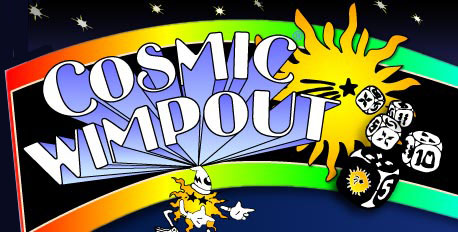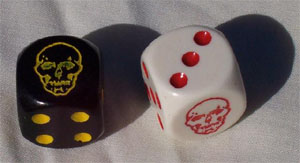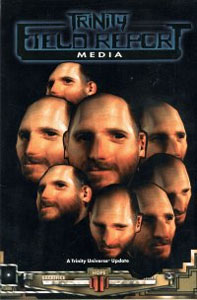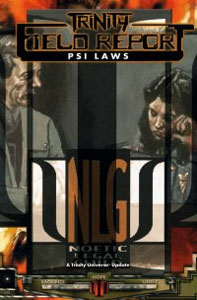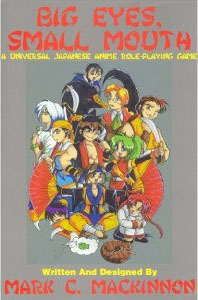 I had mixed feelings coming to Big Eyes, Small Mouth: A Universal, Japanese Anime Role-Playing Game. First off, I’m a huge fan of anime. But having seen Ranma 1/2, Slayers, 3×3 Eyes, Kamui, and Mai (among many others) I know that if you’ve got a universal anime game what you’ve really got is a universal game, period. If you strip the affectation of the animation away from anime you’ve stripped away the only common element which binds all of it together – and since I don’t spend my game sessions madly sketching animation cels…
I had mixed feelings coming to Big Eyes, Small Mouth: A Universal, Japanese Anime Role-Playing Game. First off, I’m a huge fan of anime. But having seen Ranma 1/2, Slayers, 3×3 Eyes, Kamui, and Mai (among many others) I know that if you’ve got a universal anime game what you’ve really got is a universal game, period. If you strip the affectation of the animation away from anime you’ve stripped away the only common element which binds all of it together – and since I don’t spend my game sessions madly sketching animation cels…
On the other hand I had heard nothing but unreserved praise for the game (except for a handful of people who had never laid eyes upon it declaring that they “don’t do anime” – the loss is theirs, of course). So, like I said, I came to BESM with mixed feelings.
I’m happy to say that not only were “they” right, but I was right, and Mark MacKinnon was right when he said that the game was “easy to learn, fun to play, and in the spirit of anime”.
To understand how all these contradictions resolve themselves you first have to understand how I feel about “universal games”. Many have said that a “truly universal” roleplaying game is impossible. When some people say that they mean that no single game engine can satisfy everybody. This is true. When some other people say that they mean that no single game engine can model at multiple levels simultaneously – a simple engine cannot adequately model ultra-realism; a complex engine cannot adequately perform when asked to run fast and furious action. This is also true.
But when some other people say that a “truly universal” roleplaying game is impossible what they mean is that no game engine can model all possible genres.
This is false.
(Actually all of these statements except the first are false if you expand them to include meta-systems in addition to systems proper. A meta-system such as FUDGE, for example, which gives you systems to modify the system itself can easily modulate itself to handle multiple levels simultaneously.)
It is false because it has been done quite successfully several times. GURPS and Hero, for starters, are both very successful at being universal engines – they just suck at being simple systems.
Which brings us back to BESM, which succeeds quite handily at being a universal anime game by giving us a set of rules which is quite adept at modeling the type of reality postulated by about 95% of the anime out there (it can model the other stuff, too, it just won’t be quite as good at it). You end up with fast, furious combat. You end up with simple, but richly developed characters. You end up, in short, with a very good game which is capable of not only handling your favorite anime – but just about any other story you care to throw at it. Sure it’ll handle some things better than others (the same way that GURPS handles modern day realism better than it will ever handle super-heroes or Hong Kong action flicks), but it will handle it.
THE BASIC SYSTEM
BESM is simple. Dead simple. Character creation:
1. Assign Stats. Roll 2d6, add 10 and distribute the points between your Body, Mind, and Soul stats.
2. Character Attributes. Take 10, 15, or 20 points (depending on the level of campaign your GM wants to run) and assign them to your attributes. These are things like “Extra Attacks” and “Own Big Robot (OBR)”; the more points you assign to each one, the more signficant that attribute is.
3. Character Defects. Take up to 3 defects (each worth either 1 or 2 bonus points, depending on their severity, which can be spent on other things).
4. Derived Values. Calculate your Combat Value, Health, and Energy Points from your basic stats and attributes.
(There are actually eight steps to character creation outlined in the book – I’ve omitted the ones that are purely conceptual in basis.)
Taking actions? Make a stat check by rolling 2d6 under your stat (modified by the difficulty of the situation). Combat? Initiative is determined through a die roll compared to your Combat Value. You can take one offensive and one defensive action in a round. To attack you roll 2d6 under your Combat Value. To defend you roll 2d6 under your Combat Value (negating damage). Damage equals your Combat Value plus the Weapon Damage Value. Mental combat is essentially identical with a couple of twists.
That’s basically it, folks. It don’t get much easier than this.
ANALYSIS
Before going any further, let’s get the bad stuff out of the way. First, while the art in the book is good, it is not great. Considering that the game is entirely built upon the precepts of a visual medium this was a little disappointing, but not heartbreaking. It’s clean line art and, like I said, is good. It just ain’t Takahashi.
Second, I consider the summary of all physical characteristics into the Body stat to be a mistake. I can name quite a few anime titles off the top of my head (Ranma 1/2 and Project A-ko for example) in which a massive, physically powerful character is laid waste by the quicker, faster main character. This is moderated somewhat by some elements of the attribute system (such as “Extra Attacks”), so it isn’t a complete killer.
Speaking of “Extra Attacks”, however, brings me to my next objection. Each point you put into “Extra Attacks” only gives you one extra attack and defense in a combat round. Since you can only put five points into an attribute this means you can’t get more than six attacks in one round. Considering that Ranma can throw a couple hundred punches in the blink of an eye I found this tough to swallow. Sure this can be moderated, once again, if you begin to bring some other attributes into play (such as “Massive Damage”) and fudge around the edges – but now we’re edging more towards the power meta-system of Hero, and that’s painfully out of place in a game this simple.
And as long as we’re obsessing over the attribute system, let me point out the final injustice of all. Most of these attributes are very loose in describing what their actual effects are. This is understandable considering the breadth which must be covered by fairly simple categories. (“Item of Power”, for example, describes the Level 3 as being “item offers a good advantage to the character.” This is differentiated from Level 4, which “offers a great advantage to the character”.) My objection, as noted, is not this level of abstraction – rather it is the last attribute listed in the book: Unique Character Attribute. This is “covers” anything “not detailed above an anime character might possess”. While an understandable kludge (you can’t be expected to list everything) the insult is rubbed in when a list of twenty or so examples are then given. Considering how vague some of the preceding attributes were (others were quite concrete – like “Extra Attacks”) what was the point of this list?
Another minor quibble would be the partial randomization of attributes. As a general rule I dislike this. In specific I find it rather bizarre in this system, which is designed with open-ended interpretation in mind (note the vague, guideline-like nature of the attributes) to suddenly tie itself into the need for randomization. You trust your players to know the difference between a “good” item of power and a “great” item of power, but not enough to responsibly handle the point totals for character creation? On the plus side, there’s an optional rule that fixes all this.
Alright, that’s all the bad stuff out of the way. It makes quite a list, but you can ignore most of that because the system’s too simple for you to be sweating the small stuff. The cool things about this game far outweigh the bad.
First, as I’ve mentioned before this is a simple, elegant system. If you’re looking for a simple system which is also fairly rigid and objectively consistent you don’t want to look here (although you might want to take a look over at Unknown Armies, which has done that very well). This is a simple system which provides you with a very rough guide to how things should go – it is a framework on which stories are draped. It is just enough removed from cops and robbers that you’re not going to get into arguments over whether or not you were shot, but it also hasn’t become so formalized that the rules seriously bind you into much of anything. Sometimes that’s just the type of balance you need. And BESM finds that balance very, very well.
Second, this is a very well put together manual. It is very short and undersized, but that’s okay considering how simple the rules are (and the price – you aren’t being overcharged for the material). MacKinnon has done a simply brilliant job of organizing the material in a logical order and then, for added goodness, isolating the important information into two flow-charts (one for character creation and one for action resolution) and a single table (of weapon damage values). You can run the game from those three single-page references and never have to look at the rules. On top of it all a readable, clear font was used.
Third, there’s a lot of good stuff crammed in there besides the game. You’ve got an introduction to anime and roleplaying; plus a section on advice for players and GMs; a nice summation of anime adventure settings and adventure themes set in each of those settings; a bibliography of major anime series; a list of anime resources; a few optional rules; biographies of the creators; and (perhaps the most important test of all) a thorough, complete index.
All in all, Guardians of Order should be very proud of its first foray into publishing a roleplaying game. The game itself is good and well worth the money, but by including an extensive index and demonstrating more than competent organizational skills they’ve proven that they are capable of turning out high quality product in the future. I look forward to taking a look at their Sailor Moon game as soon as I get a chance.
CONCLUSION
What I think BESM would really excel at is as a introductory roleplaying game. The subject matter (capable of covering everything from Pokemon to Sailor Moon) is something which easily captures the attention of young children. The rules are simple and easy to learn, plus a strong emphasis is put on character over hack ‘n slash play (this is one of the few books that includes a section on player advice, instead of just GM advice). The book itself is cheap enough that you can easily afford to buy multiple copies for a group you’re interested in converting.
Beyond that, though, BESM is simply a very good game. It is far too simplistic, in my opinion, to successfully support a long-term campaign, but I will definitely be giving it consideration the next time I sit down to design a one-shot or short series. At fourteen bucks I don’t think you can go wrong here – whether you like anime or not. (And if you don’t you’re not hurting anyone but yourself through your sad negligence of an amazing medium. “Time spent watching anime,” as MacKinnon says, “Is time well spent.”)
Style: 4
Substance: 4
Author: Mark C. MacKinnon
Company/Publisher: Guardians of Order
Cost: $13.95
Page count: 96
ISBN: 0-9682431-0-X
Originally Posted: 1999/04/26
It’s strange looking back at the earliest days of Guardians of Order, as we all began to figure out that this plucky little upstart was bringing something really special to the industry. Sadly, we also couldn’t foresee their eventual downfall. They came close to nailing something really special… but somehow they just missed it.
The second edition of Big Eyes, Small Mouth remains one of my “generic triumvirate”: If I’m looking for a generic system to run something, the first games I look to are BESM2, Hero, and D20. (It used to be BESM2, Hero, and Silhouette. But I haven’t run anything using the Silhouette system in over a decade.)
For an explanation of where these reviews came from and why you can no longer find them at RPGNet, click here.

